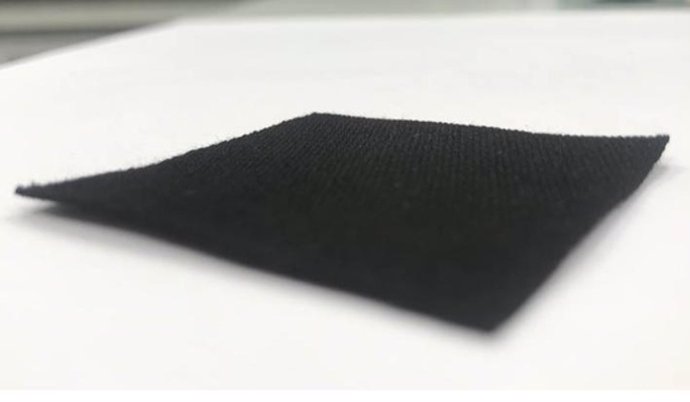Sample of activated carbon used to capture carbon dioxide. – UNIVERSITY OF CAMBRIDGE/ALEX FORSE
June 13. () –
Cambridge chemists have used a method similar to charging a battery to charge activated carbon, which It is often used in home water filters.
By loading the carbon “sponge” with ions that form reversible bonds with CO2, the researchers discovered that the loaded material could successfully capture CO2 directly from the air.
The charged carbon sponge is also potentially more energy efficient than current carbon capture methods, requiring much lower temperatures to remove the captured CO2 so it can be stored. The results are published in the journal Nature.
“Capturing carbon emissions from the atmosphere is a last resort, but given the scale of the climate emergency, it is something we must investigate,” he said. it’s a statement Dr. Alexander Forse from the Department of Chemistry, who led the research.
“The first and most urgent thing we need to do is reduce carbon emissions around the world, but it is also believed that removing greenhouse gases is necessary to achieve net zero emissions and limit the worst effects of climate change. Realistically, we have to do everything we can“.
Direct air capture, which uses sponge-like materials to remove carbon dioxide from the atmosphere, is a potential approach for carbon capture, but current approaches are expensive, require high temperatures and the use of natural gas, and They lack stability.
“There has been some promising work done on using porous materials for carbon capture from the atmosphere,” Forse said. “We wanted to see if activated charcoal could be an option, since It is cheap, stable and manufactured on a large scale.
Activated carbon is used in many purification applications, such as water filters, but it typically cannot capture and retain CO2 from the air. Forse and his colleagues proposed that if activated carbon could be charged, like a battery, could be a suitable material for carbon capture.
When charging a battery, charged ions are inserted into one of the battery’s electrodes. The researchers hypothesized that loading activated carbon with chemicals called hydroxides would make it suitable for carbon capture, since hydroxides form reversible bonds with CO2.
The team used a battery-like charging process to charge an inexpensive activated carbon cloth with hydroxide ions. In this process, the fabric essentially acts as an electrode in a battery, and hydroxide ions accumulate in the tiny pores of the carbon. At the end of the charging process, the carbon is removed from the “battery”, washed and dried.
Tests of the loaded carbon sponge showed that it could successfully capture CO2 directly from the air, thanks to the hydroxide binding mechanism.
“It’s a new way of making materials, using a process similar to that of a battery,” Forse said. “And the CO2 capture rates are already comparable to those of current materials. But what is even more promising is that this method could consume much less energy, since “We don’t need high temperatures to collect the CO2 and regenerate the carbon sponge.”
To collect CO2 from coal so it can be purified and stored, the material is heated to reverse the hydroxide-CO2 bonds. In most materials currently used for capturing CO2 from the air, the materials must be heated to temperatures up to 900°C, often using natural gas. However, the charged carbon sponges developed by the Cambridge team only require heating to 90-100°C, temperatures that can be achieved using renewable electricity. Materials are heated through resistive heating, which essentially heats them from the inside out, which makes the process faster and consumes less energy.
However, the materials have limitations that researchers are now working on. “We are working now to increase the amount of carbon dioxide that can be captured, and particularly in wet conditions where our performance decreases,” Forse said.
The researchers say their approach could be useful in fields beyond carbon capture, as the pores of the carbon and the ions inserted into them can be tuned to capture a variety of molecules.
“This approach was kind of a crazy idea we came up with during the Covid-19 lockdowns, so it’s always exciting when these ideas actually work,” Forse said. “This approach opens a door to the manufacture of all types of materials for different applications, in a way that is simple and energy efficient.”
A patent has been filed and the research is being commercialized with the support of Cambridge Enterprise, the university’s commercialization arm.










![[Img #74662]](https://thelatestnews.world/wp-content/uploads/2024/12/Organisms-with-the-shortest-life-150x150.jpg)



![[Img #74662]](https://thelatestnews.world/wp-content/uploads/2024/12/Organisms-with-the-shortest-life-300x200.jpg)

Add Comment